Structural Response of Double-Layer Steel Cylinders under Inside-Explosion Loading
Abstract
:1. Introduction
2. PDV Measurement System
3. Experimental Scheme
4. Analysis of Experimental Results
4.1. Results of PDV Measurement
4.2. Deformation of the Double-Layer Cylindrical Shells
5. The Numerical Simulation of Double-Layer Cylindrical Shells
5.1. The Model of Numerical Simulation
5.2. The Equation of Numerical Simulation
5.3. Results of Numerical Simulation
5.3.1. Shock Wave Pressure in the Double-Layer Shells
5.3.2. Analysis of Collision Process of the Inner and Outer Steel Shells
5.3.3. The Velocities of Double-Layer Cylindrical Shells by Simulation
6. Conclusions
- (1)
- This paper proposed a new method for measuring the deformation of double-layer steel cylindrical shells under internal explosion by PDV; the results of the deformation of the inner and outer cylindrical shells by PDV and numerical simulation are basically matched. Comparing the post-experimental results of the deformation of the double-layer shells with the results of the PDV and numerical simulations, it can be found that the error of maximum deformation is less than 10%.
- (2)
- The vibration period of the outer cylindrical shell and the time for reflection of the stress wave in the outer shell given by the numerical simulation and PDV measurement are consistent.
- (3)
- When the gap between the double-layer cylinders is constant, the deformation range of the outer cylinder is ± 1R, which is significantly smaller than the single-layer cylinder with an increase in the thickness of the inner cylinder, while the deformation range of the inner cylinder, which is in the range ± 1.4R, is significantly greater than the outer cylinder.
- (4)
- When the thickness of the inner layer increases, the maximum deformation of the inner cylinder gradually decreases. It can be seen from the trend of the deformation of the inner shell that the inner thickness has increased to a certain value of which the limiting case is a single-layer cylinder.
Author Contributions
Funding
Institutional Review Board Statement
Informed Consent Statement
Data Availability Statement
Conflicts of Interest
Abbreviations
| Symbol List | |
| k0 | incident light vector; |
| k | scattering light vector; |
| v | particle velocity vector, m/s; |
| ω0 | frequency of incident light, Hz; |
| ω | frequency of scattered light, Hz; |
| θ | phase; |
| λ0 | laser wavelength in vacuum, nm; |
| v(t) | velocity of object movement, m/s; |
| Q | explosive yield, gTNT; |
| L | length of double-layer steel cylinders, mm; |
| R | internal radius of double-layer steel cylinders, mm; |
| h1 | thickness of inner steel cylinder, mm; |
| Δ | gap between inner steel cylinder and outer steel cylinder, mm; |
| h2 | thickness of outer steel cylinder, mm; |
| γ | adiabatic index; |
| ρ0 | the ideal gas initial density, kg/m3; |
| e0 | initial specific internal energy, kJ/kg; |
| P0 | initial air pressure, kPa; |
| specific volume; | |
| ρ00 | initial density of explosion, kg/m3; |
| A0 | parameter of explosion, GPa; |
| B0 | parameter of explosion, GPa; |
| R1 | parameter of explosion; |
| R2 | parameter of explosion; |
| * | parameter of explosion; |
| A | steel shell yield strength at strain rate of 1 s−1, MPa; |
| B | steel shell strain hardening coefficient, MPa; |
| n | steel shell strain hardening index; |
| C | steel shell strain rate correlation index; |
| ε* | reference strain ratio; |
| C0 | velocity that stress wave propagates in steel, m/s. |
| ID | Internal Diameter |
References
- Duffey, T.; Krieg, R. The effects of strain-hardening and strain-rate sensitivity on the transient response of elastic-plastic rings and cylinders. Int. J. Mech. Sci. 1969, 11, 825–844. [Google Scholar] [CrossRef]
- Zhong, F.P.; Ma, Y.J.; Zhang, D.Z. Research on plastic deformation of multi-layer cylindrical steel tube subjected to blasts of spherical and cylindrical charges. Acta Armamentarii 2009, 30, 194–196. [Google Scholar]
- Cui, Y.X.; Hu, Y.L.; Wang, C.M. Dynamic response of multi-layer steel cylinder under internal intense blast loading. Explos. Shock Waves 2015, 35, 820–824. [Google Scholar]
- Wang, D.; Qin, X.; Chen, W.; Wang, S. Simulation of the Deformation and Failure Characteristics of a Cylinder Shell under Internal Explosion. Appl. Sci. 2022, 12, 1217. [Google Scholar] [CrossRef]
- Malekan, M.; Khosravi, A.; Cimini, C.A. Deformation and fracture of cylindrical tubes under detonation loading: A review of numerical and experimental analyses. Int. J. Press. Vessel. Pip. 2019, 173, 114–132. [Google Scholar] [CrossRef]
- Hiroe, T.; Fujiwara, K.; Hata, H.; Takahashi, H. Deformation and fragmentation behavior of exploded metal cylinders and the effects of wall materials, configuration, explosive energy and initiated locations. Int. J. Impact Eng. 2008, 35, 1578–1586. [Google Scholar] [CrossRef] [Green Version]
- Du, Y.; Ma, L.; Zheng, J. Fracture of Cylindrical Shells Subjected to Internal Explosion: Numerical Simulation. Procedia Eng. 2015, 130, 1695–1704. [Google Scholar] [CrossRef] [Green Version]
- Ryzhanskii, V.A.; Syrunin, M.A. Explosion resistance of a steel cylindrical shell. Combust. Explos. Shock Waves 2011, 47, 115–122. [Google Scholar] [CrossRef]
- Wu, J.; Ji, C.; Long, Y.; Song, K.; Liu, Q. Dynamic responses and damage of cylindrical shells under the combined effects of fragments and shock waves. Thin-Walled Struct. 2017, 113, 94–103. [Google Scholar] [CrossRef]
- McDonald, B.; Bornstein, H.; Langdon, G.; Curry, R.; Daliri, A.; Orifici, A. Experimental response of high strength steels to localised blast loading. Int. J. Impact Eng. 2018, 115, 106–119. [Google Scholar] [CrossRef]
- Zheng, K.; Xu, X. Experimental and Numerical Study on the Mechanical Behavior of Composite Steel Structure under Explosion Load. Materials 2021, 14, 246. [Google Scholar] [CrossRef] [PubMed]
- Yin, C.; Jin, Z.; Chen, Y.; Hua, H. Effects of sacrificial coatings on stiffened double cylindrical shells subjected to underwater blasts. Int. J. Impact Eng. 2019, 136, 103412. [Google Scholar] [CrossRef]
- Huang, S.Z.; Tong, X.D. Effects of Internal Fluid on the Dynamic Behaviors of Double Cylindrical Shells Subjected to Underwater Explosion. J. Offshore Mech. Arct. Eng. 2022, 144, 1–27. [Google Scholar] [CrossRef]
- Ning, J.; Meng, F.; Ma, T.; Xu, X. A special numerical method for fluid-structure interaction problems subjected to explosion and impact loading. Sci. China Technol. Sci. 2020, 63, 1280–1292. [Google Scholar] [CrossRef]
- Nassiraei, H.; Yara, A. Local joint flexibility of tubular K-joints reinforced with external plates under IPB loads. Mar. Struct. 2022, 84, 103199. [Google Scholar] [CrossRef]
- Van Vinh, P.; Avcar, M.; Belarbi, M.-O.; Tounsi, A.; Huy, L.Q. A new higher-order mixed four-node quadrilateral finite element for static bending analysis of functionally graded plates. Structures 2023, 47, 1595–1612. [Google Scholar] [CrossRef]
- Van Vinh, P.; Van Chinh, N.; Tounsi, A. Static bending and buckling analysis of bi-directional functionally graded porous plates using an improved first-order shear deformation theory and FEM. Eur. J. Mech.-A/Solids 2022, 96, 104743. [Google Scholar] [CrossRef]
- Zheng, C.; Kong, X.-S.; Wu, W.-G.; Xu, S.-X.; Guan, Z.-W. Experimental and numerical studies on the dynamic response of steel plates subjected to confined blast loading. Int. J. Impact Eng. 2018, 113, 144–160. [Google Scholar] [CrossRef]
- Yao, S.; Zhao, N.; Jiang, Z.; Zhang, D.; Lu, F. Dynamic Response of Steel Box Girder under Internal Blast Loading. Adv. Civ. Eng. 2018, 2018, 1–12. [Google Scholar] [CrossRef] [Green Version]
- Fu, S.; Gao, X.; Chen, X. The similarity law and its verification of cylindrical lattice shell model under internal explosion. Int. J. Impact Eng. 2018, 122, 38–49. [Google Scholar] [CrossRef]
- Wang, H.; Li, Z.; Wu, Y.; Shao, L.; Yao, M.; Liao, Z.; Tang, D. Numerical Simulation Study on Factors Influencing Anti-Explosion Performance of Steel Structure Protective Doors under Chemical Explosion Conditions. Materials 2022, 15, 3880. [Google Scholar] [CrossRef]
- Rajendran, R.; Narashimhan, K.; Narasimhan, K. Performance Evaluation of HSLA Steel Subjected to Underwater Explosion. J. Mater. Eng. Perform. 2001, 10, 66–74. [Google Scholar] [CrossRef]
- Zhong, F.P.; Chen, C.Y.; Lin, J.D. Experimental study of dynamic response of double-walled explosion vessels with flat head. Explos. Shock Waves 1999, 19, 199–203. [Google Scholar]
- Tang, T.G.; Gu, Y.; Li, Q.Z. Expanding fracture of steel cylinder shell by detonation driving. Explos. Shock Waves 2003, 23, 529–533. [Google Scholar]
- Hu, Y.L.; Chen, Z.C.; Wang, W. Non-contact measurement technique for dynamic radial deformation of explosion containment vessels. J. Mech. Strength 2009, 31, 759–763. [Google Scholar]
- Li, J.; Xiong, C.; Zhang, D.Z. Strain Wire Measurement Technique on Process of Circumferential Large Deformation of Cylindrical Explosion Vessels. Explos. Shock Waves 2017, 37, 976–981. [Google Scholar]
- Qin, X.J.; Zhang, D.Z.; Yang, J. Electric probe measurement technique on deformational process of cylindrical steel shell under inside-explosion loading. Explos. Shock Waves 2014, 34, 115–119. [Google Scholar]
- Yang, J.; Wang, K.Y.; Xu, H.B. Development of an optical-fiber displacement interferometer and its application in Hopkinson pressure bar experiment. Infrared Laser Eng. 2013, 42, 102–107. [Google Scholar]
- Deng, J.; Zhou, S.J.; Gao, H.J.; Lin, M.H.; Li, X. Numerical Simulation Investigation on Machining Deformation of AviationThin-Walled Parts Caused by Residual Stress. Mater. Sci. Forum 2021, 1032, 186–191. [Google Scholar] [CrossRef]
- Zhang, D.Z. Research on Dynamic Load of Cylindrical Explosive Vessel Subjected to Internal Intense Explosion; Northwest Institute of Nuclear Technology: Xi’an, China, 2012. [Google Scholar]
- Sun, C.W.; Wei, Y.Z.; Zhou, Z.K. Applied Detonation Physics; Defense Industry Press: Beijing, China, 2000. [Google Scholar]
- Zhang, B.P.; Zhang, Q.M.; Huang, F.L. Detonation Physics; Arms Industry Press: Beijing, China, 2001. [Google Scholar]

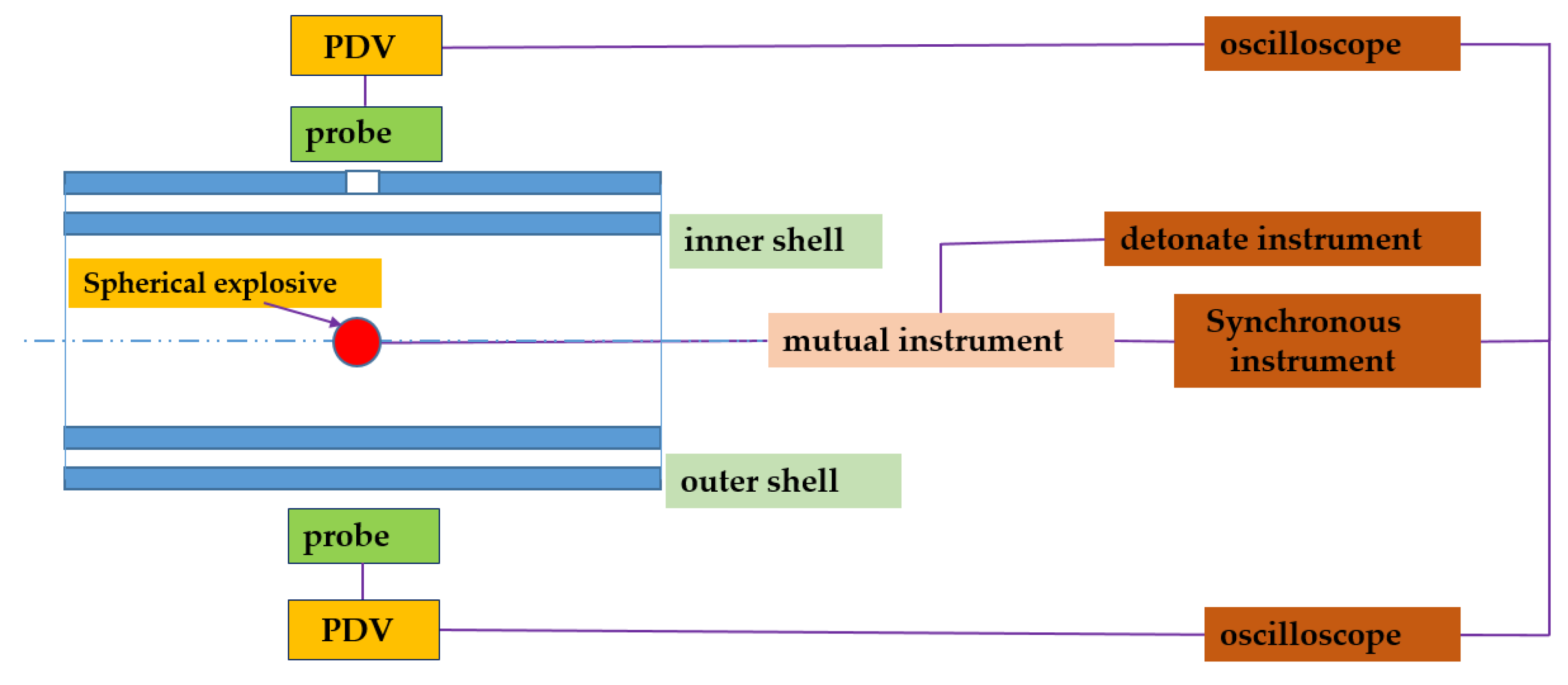
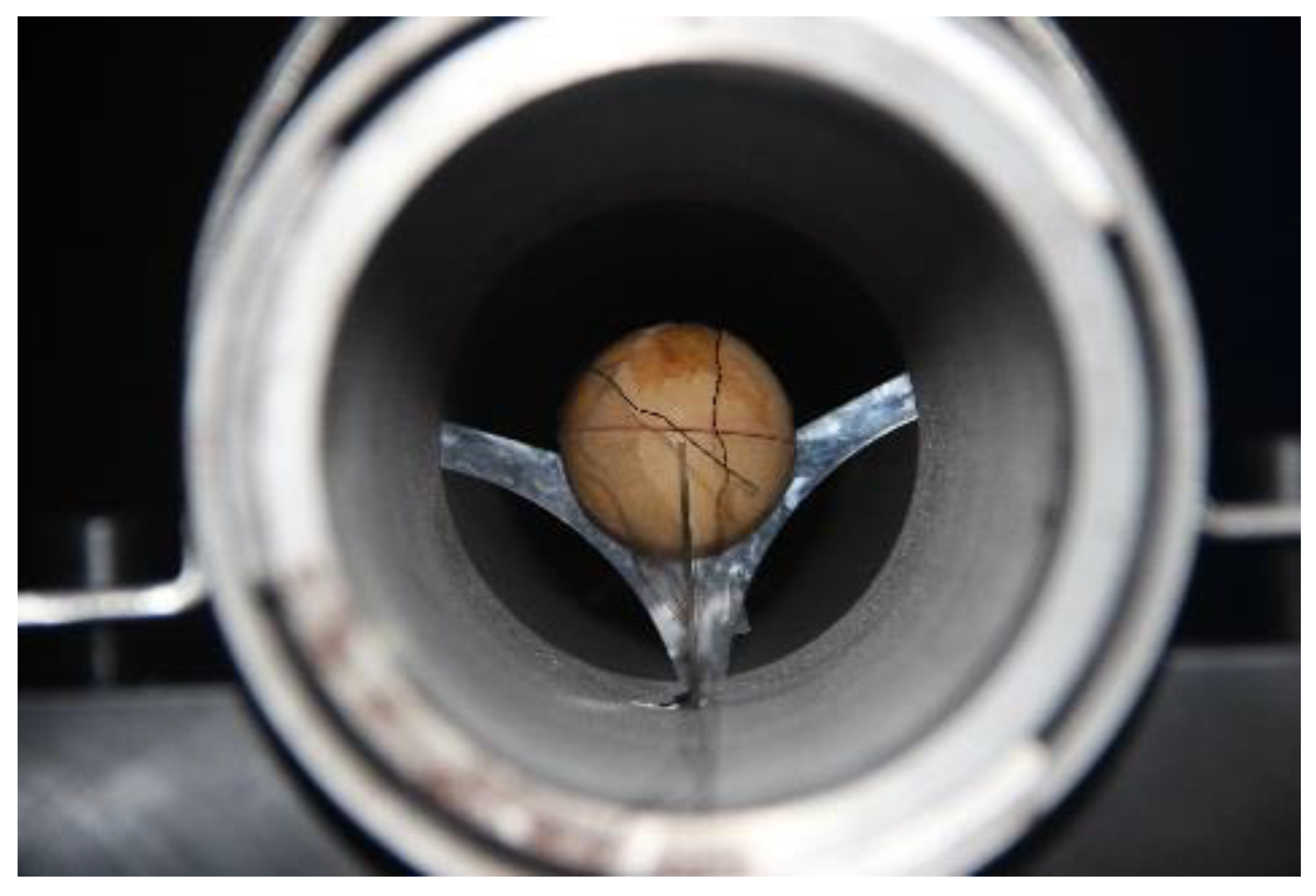
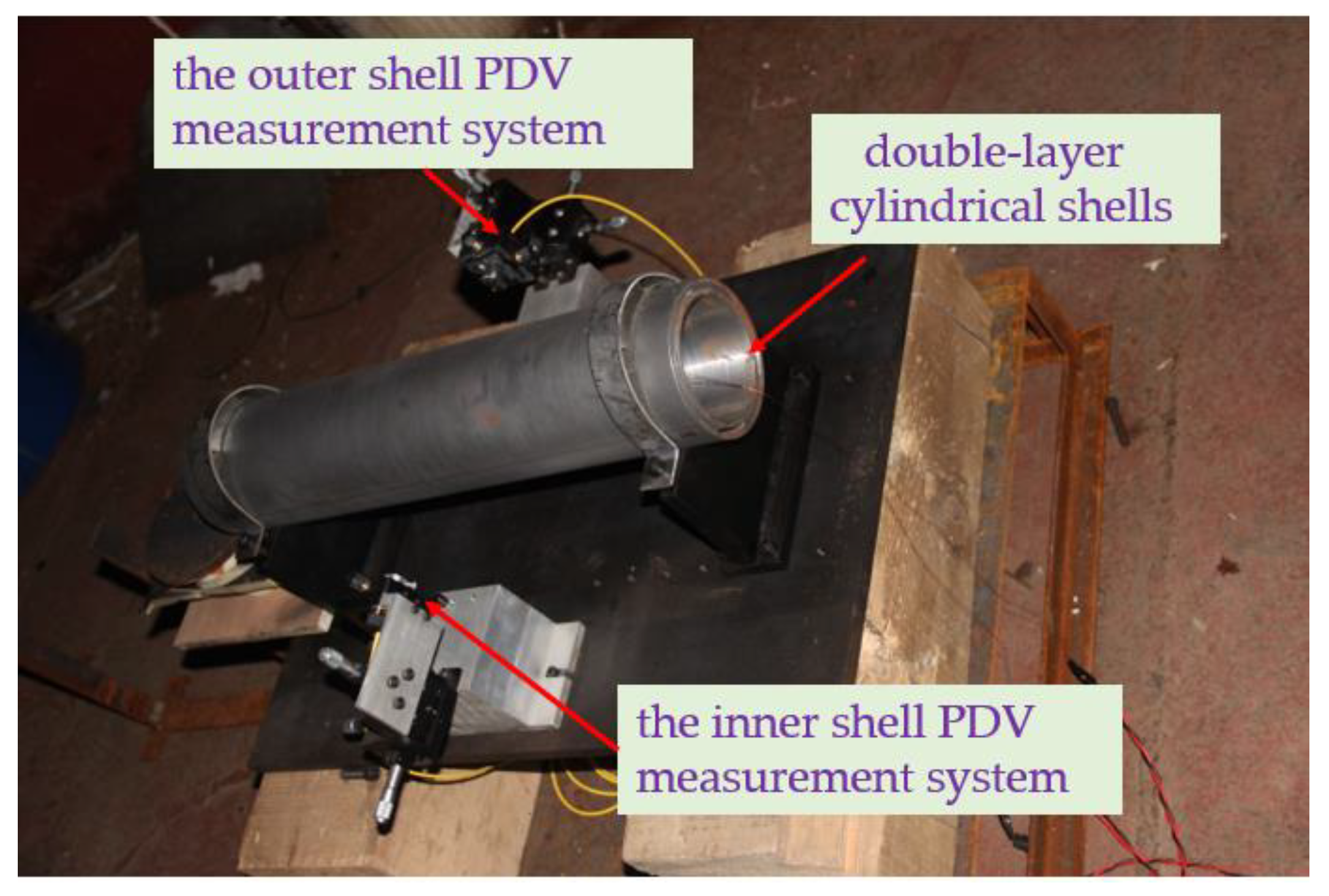
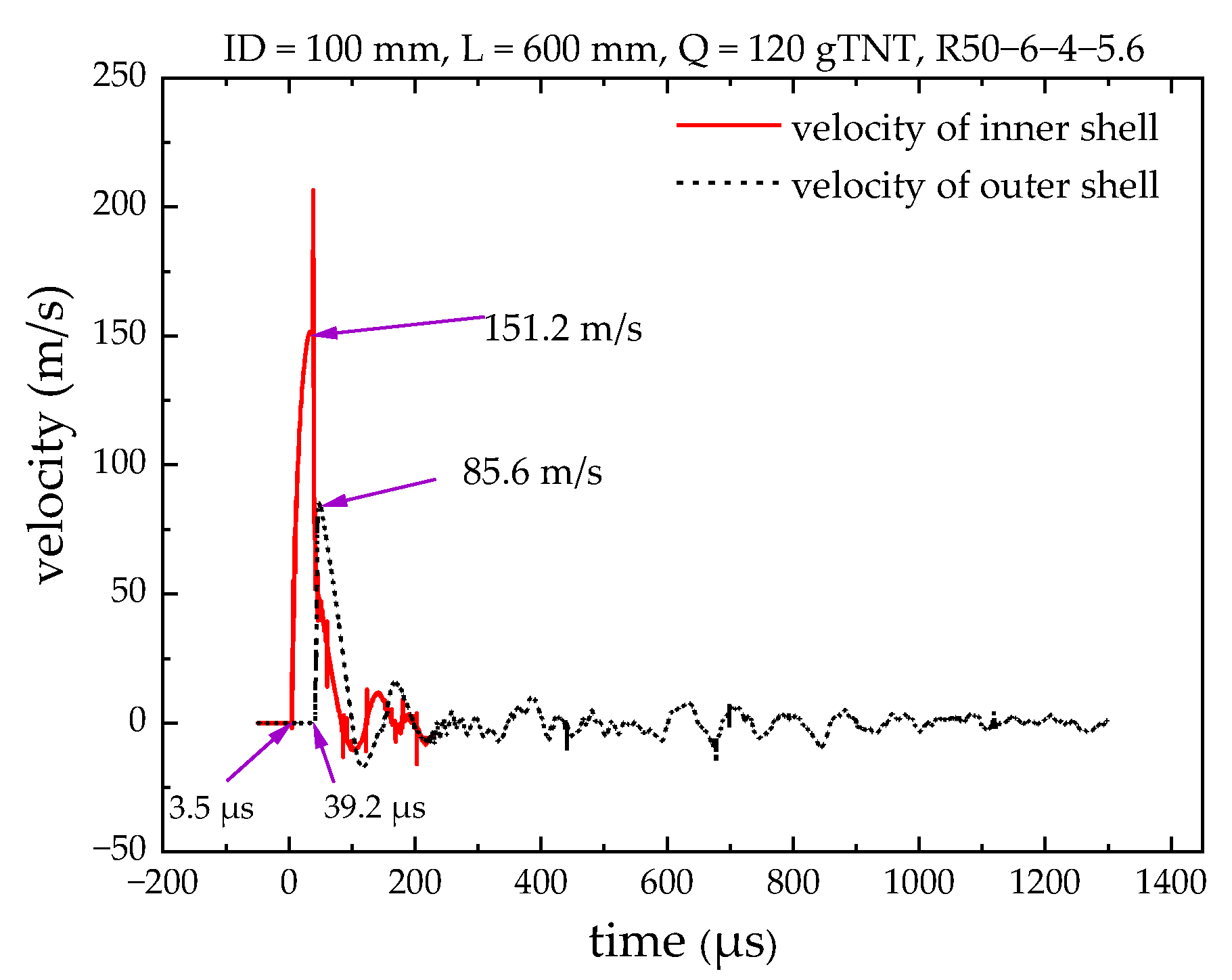
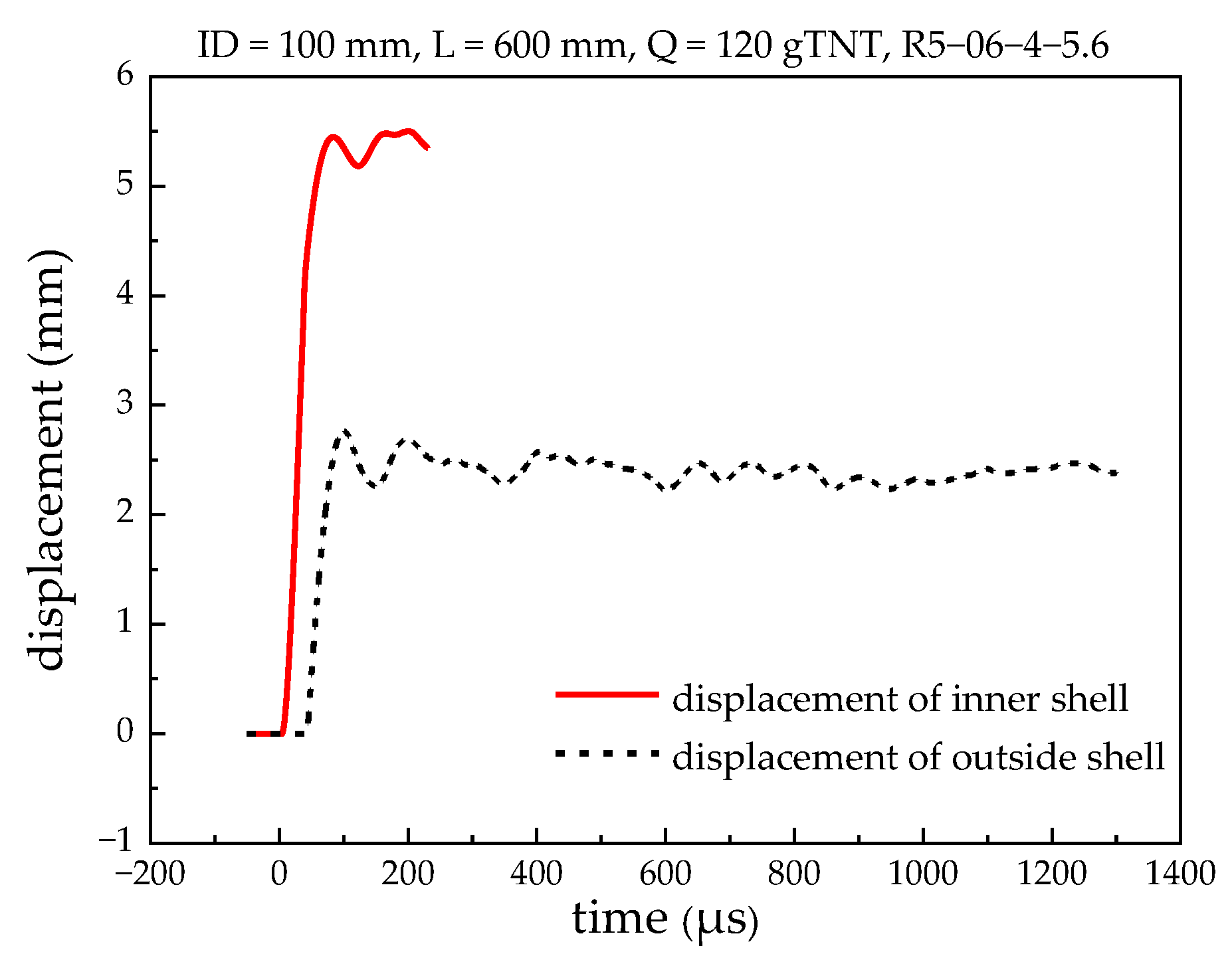

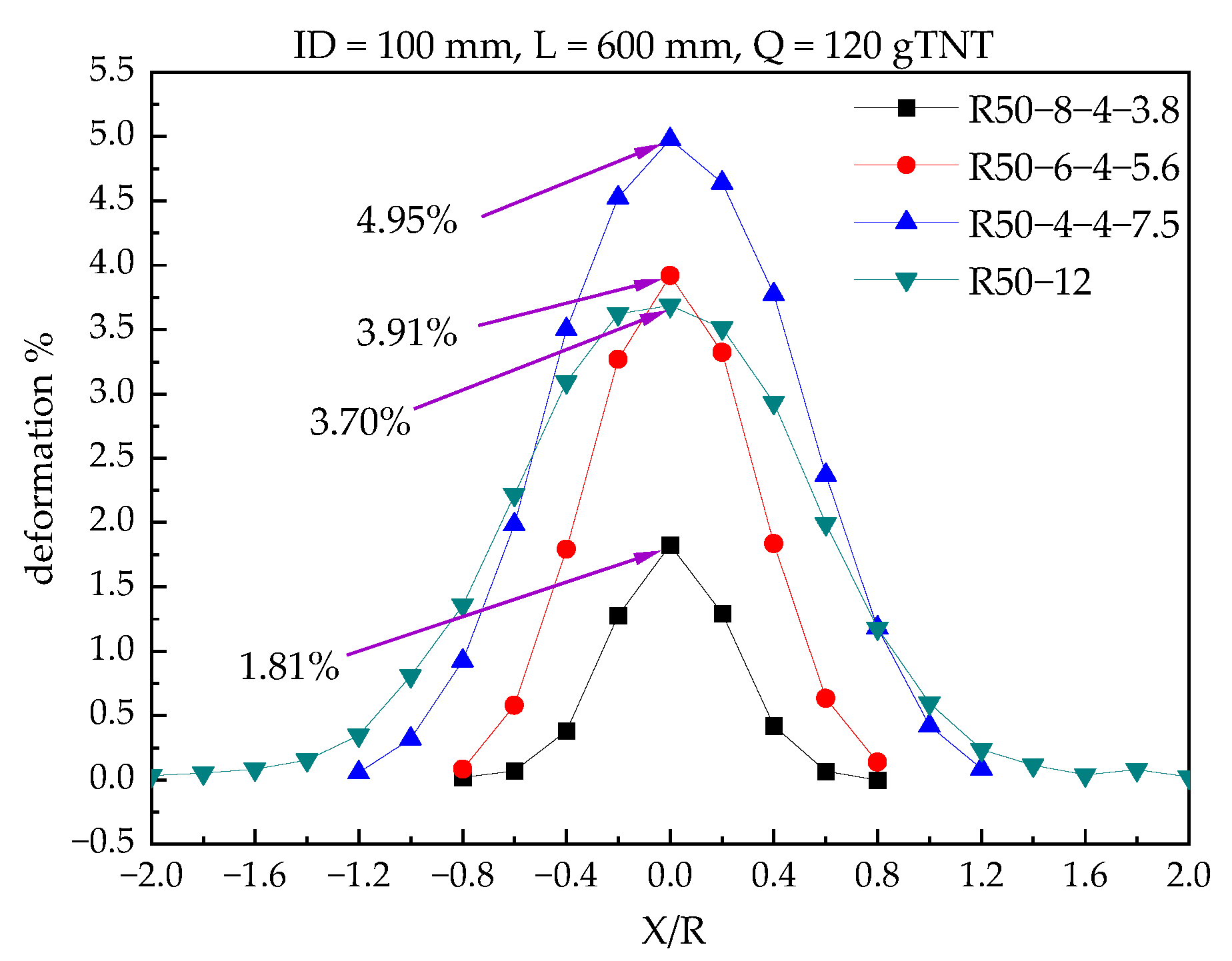
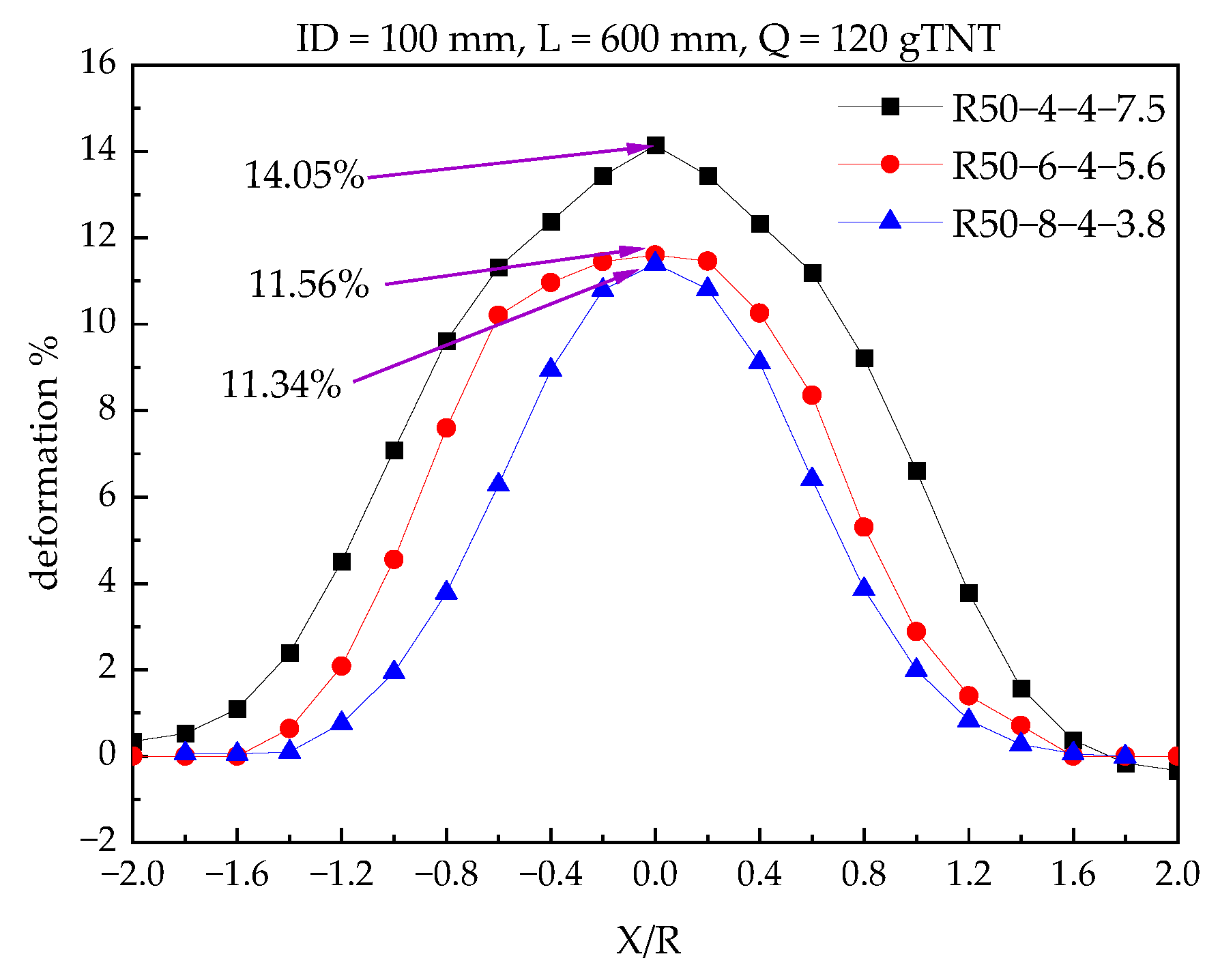

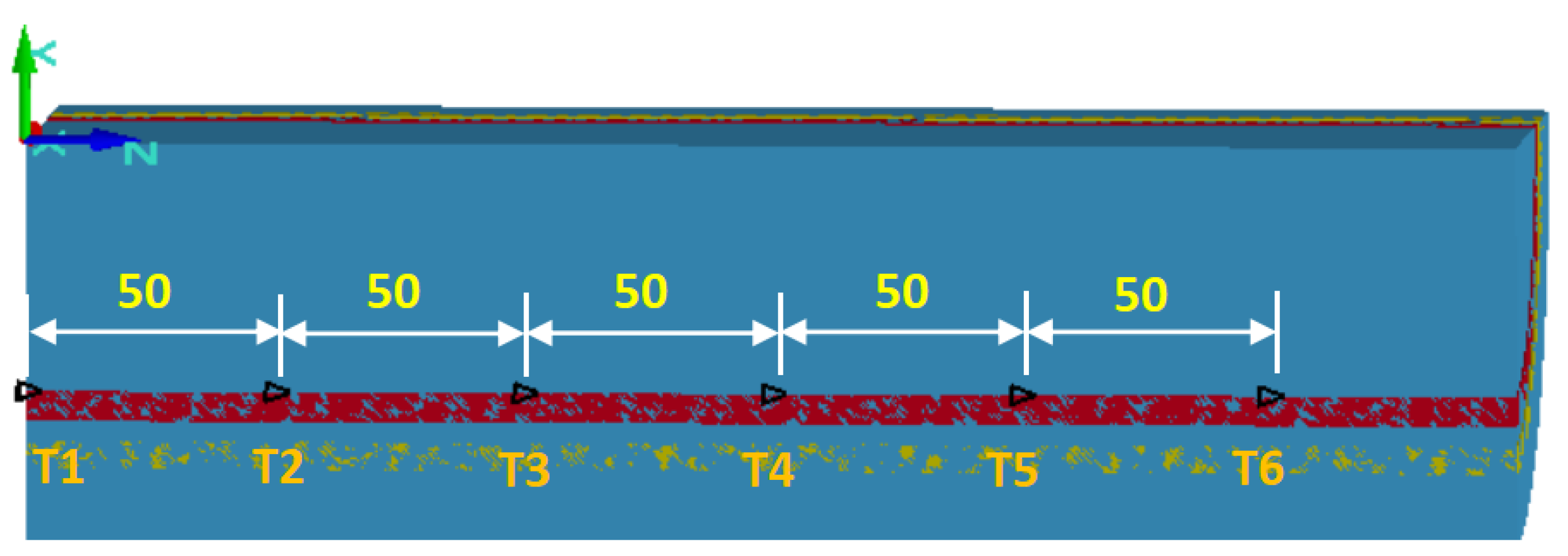
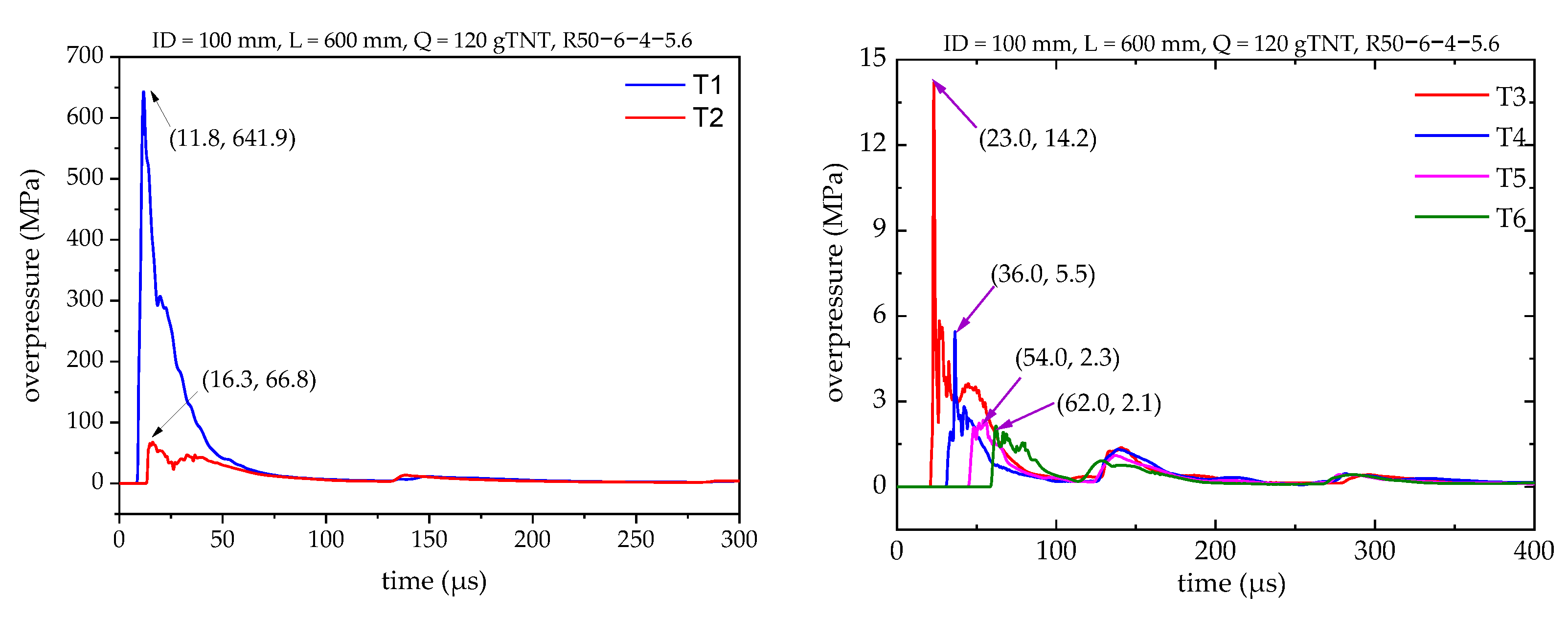

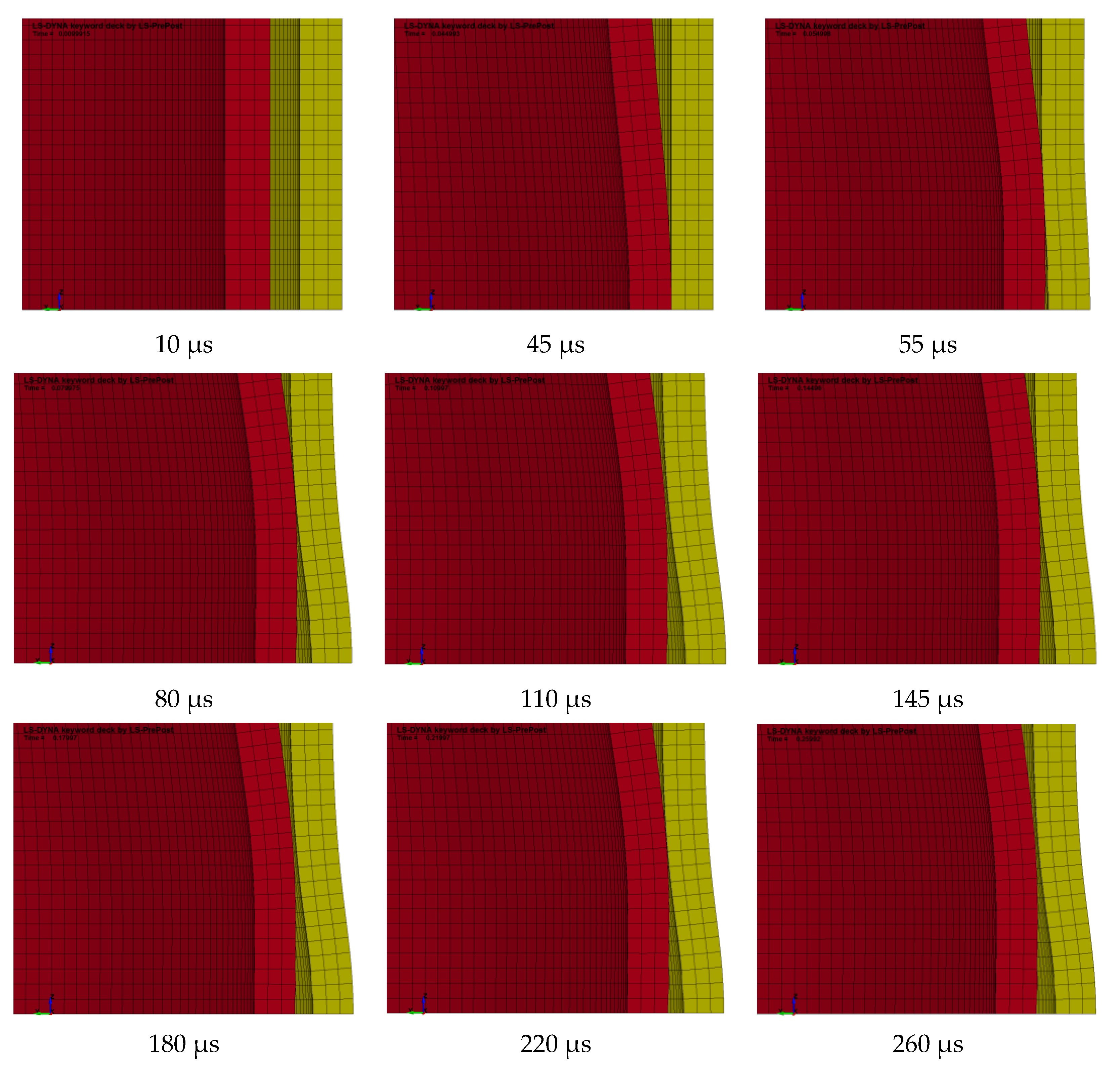
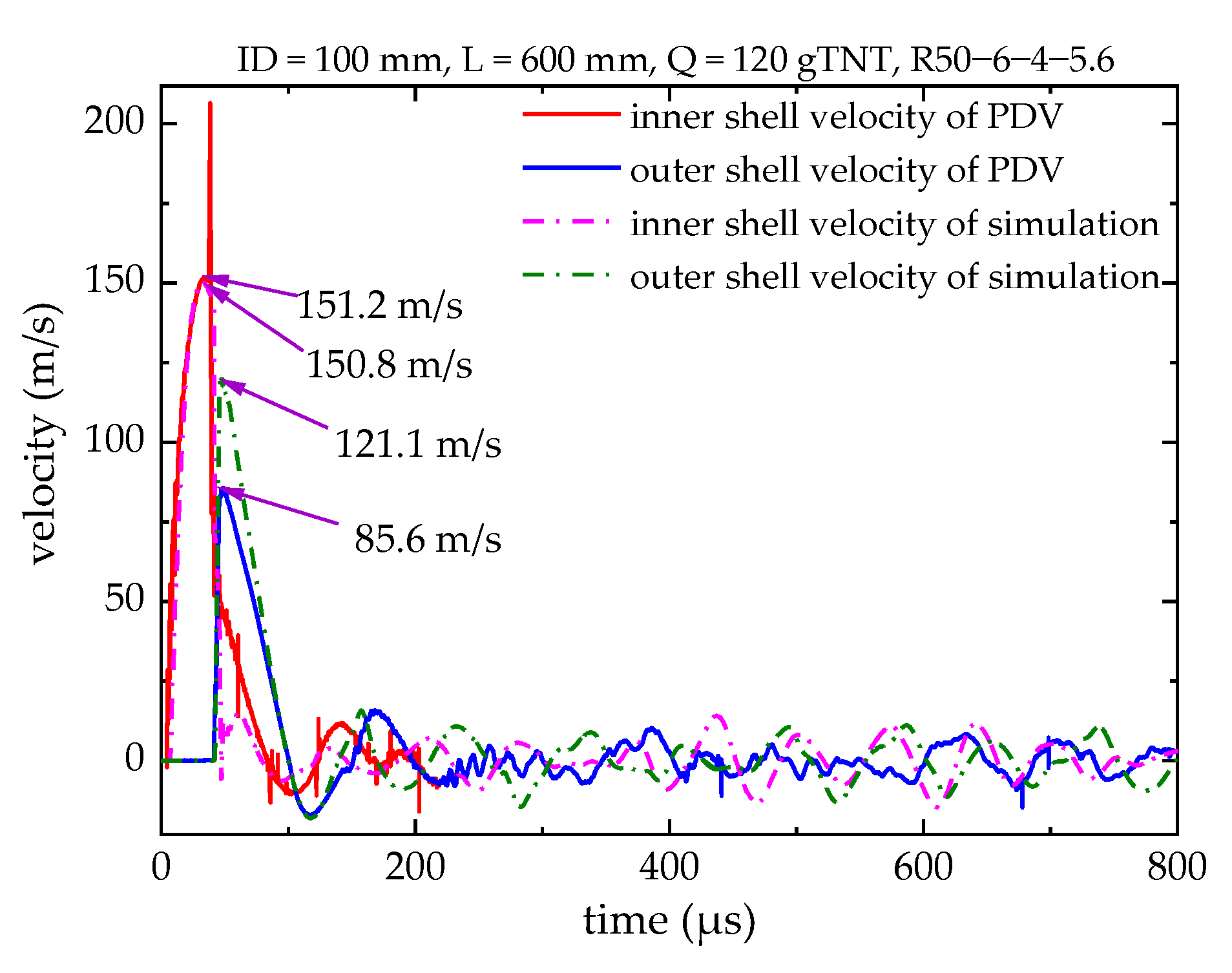
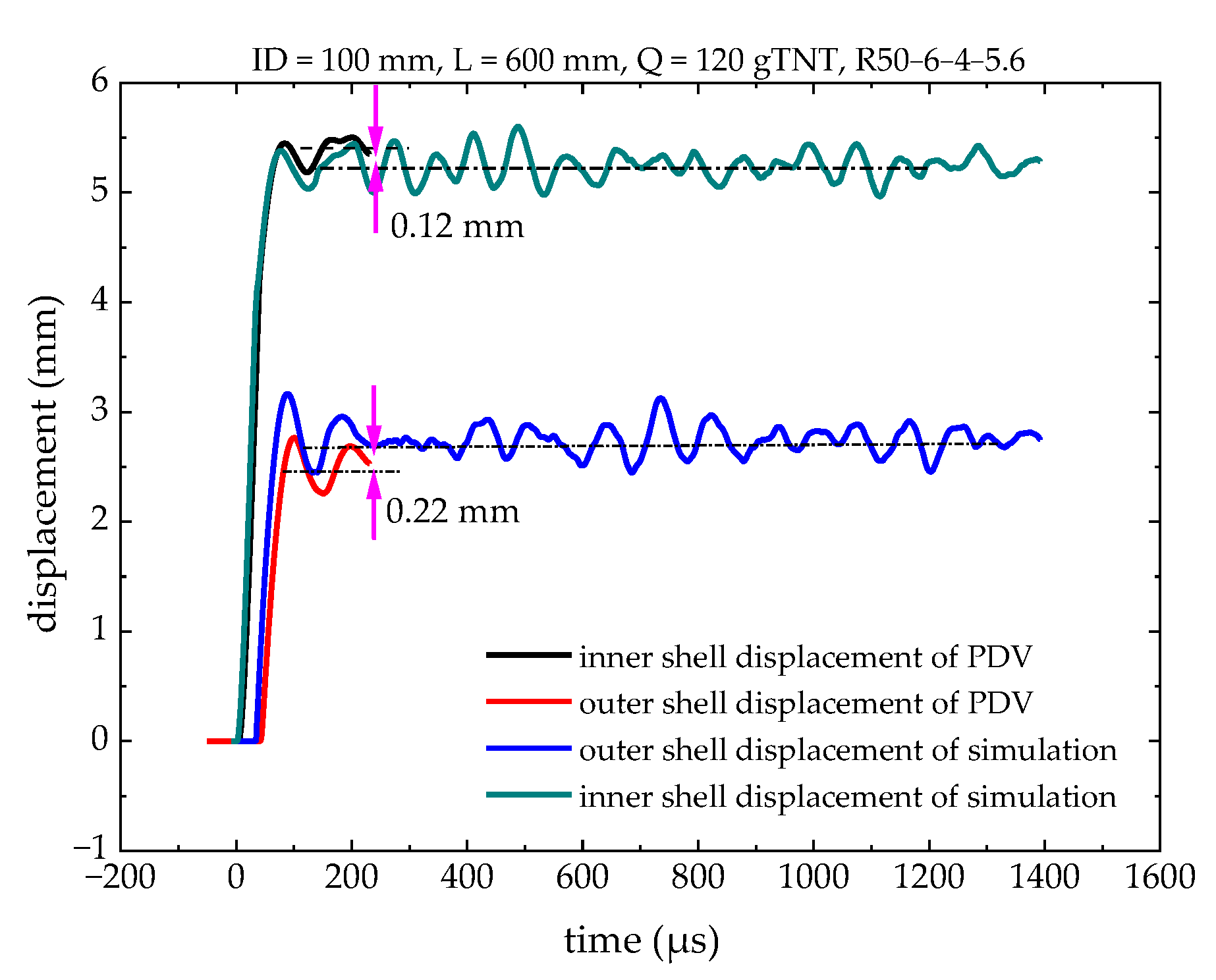


| Number | L/mm | R/mm | h1/mm | Δ/mm | h2/mm |
|---|---|---|---|---|---|
| No. 1 | 600 | 50 | 4 | 4 | 7.5 |
| No. 2 | 600 | 50 | 6 | 4 | 5.6 |
| No. 3 | 600 | 50 | 8 | 4 | 3.8 |
| Number | h1/mm | Δ/mm | h2/mm | Maximum Velocity of the Inner Shell (m/s) | Maximum Velocity of the Outer Shell (m/s) |
|---|---|---|---|---|---|
| No. 1 | 4 | 4 | 7.5 | 201.4 | 82.3 |
| No. 2 | 6 | 4 | 5.6 | 151.2 | 85.6 |
| No. 3 | 8 | 4 | 3.8 | 100.6 | 62.2 |
| Johnson-Cook Model | A/MPa | B/ MPa | n | c | Reference Strain Rate/s−1 |
| 370 | 700 | 0.4 | 0.055 | 1.0 | |
| JWL equation of state | A0/GPa | B0/GPa | ω* | R1 | R2 |
| 374 | 3.74 | 0.35 | 4.15 | 0.9 |
Disclaimer/Publisher’s Note: The statements, opinions and data contained in all publications are solely those of the individual author(s) and contributor(s) and not of MDPI and/or the editor(s). MDPI and/or the editor(s) disclaim responsibility for any injury to people or property resulting from any ideas, methods, instructions or products referred to in the content. |
© 2023 by the authors. Licensee MDPI, Basel, Switzerland. This article is an open access article distributed under the terms and conditions of the Creative Commons Attribution (CC BY) license (https://creativecommons.org/licenses/by/4.0/).
Share and Cite
Qin, X.; Yang, J.; Guan, J.; Liao, Z.; Ma, Y.; Zhang, D. Structural Response of Double-Layer Steel Cylinders under Inside-Explosion Loading. Appl. Sci. 2023, 13, 709. https://doi.org/10.3390/app13020709
Qin X, Yang J, Guan J, Liao Z, Ma Y, Zhang D. Structural Response of Double-Layer Steel Cylinders under Inside-Explosion Loading. Applied Sciences. 2023; 13(2):709. https://doi.org/10.3390/app13020709
Chicago/Turabian StyleQin, Xuejun, Jun Yang, Junyi Guan, Zhen Liao, Yanjun Ma, and Dezhi Zhang. 2023. "Structural Response of Double-Layer Steel Cylinders under Inside-Explosion Loading" Applied Sciences 13, no. 2: 709. https://doi.org/10.3390/app13020709





